1997 PONTIAC BONNEVILLE display
[x] Cancel search: displayPage 54 of 405
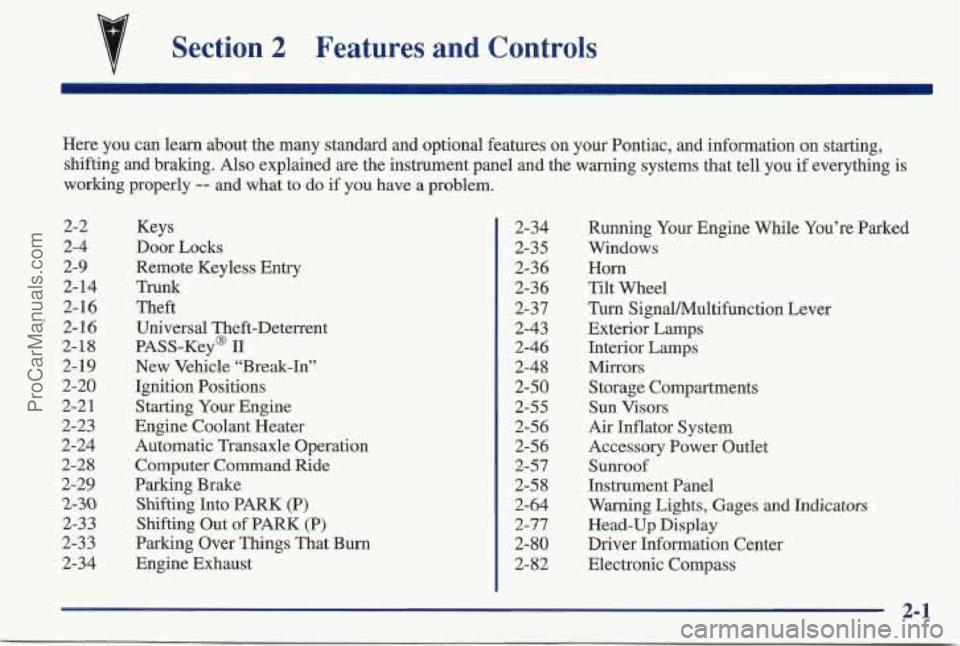
Section 2 Features and Controls
Here you can learn about the many standard and optional features on your Pontiac, and information on starting,
shifting and braking. Also explained are the instrument panel and the warning systems that tell you if everything
is
working properly -- and what to do if you have a problem.
2-2
2-4
2-9
2- 14
2-16
* 2-16
2-18
2-19
2-20
2-2
1
2-23
2-24
2-28
2-29
2-30
2-33
2-33
2-34 Keys
Door Locks
Remote Keyless Entry Trunk
Theft
Universal Theft-Deterrent
PASS-Key@
I1
New Vehicle “Break-In”
Ignition Positions
Starting
Your Engine
Engine Coolant Heater
Automatic Transaxle Operation Computer Command Ride
Parking Brake
Shifting Into PARK (P)
Shifting Out of PARK (P)
Parking Over Things That Bum
Engine Exhaust 2-34
2-3
5
2-3 6
2-36
2-37
1 2-43
~ 2-46
2-48
2-50
2-55
2-56
2-56
2-57
2-5 8
2-64
2-77
2-80
2-82 Running
Your Engine While You’re Parked
Windows
Horn
Tilt Wheel
Turn SignalMultifunction Lever
Exterior Lamps
Interior Lamps
Mirrors
Storage Compartments
Sun Visors
Air Inflator
System
Accessory Power Outlet
Sunroof
Instrument Panel
Warning Lights, Gages
and Indicators
Head-Up Display
Driver Information Center
Electronic Compass
2-.l
ProCarManuals.com
Page 73 of 405
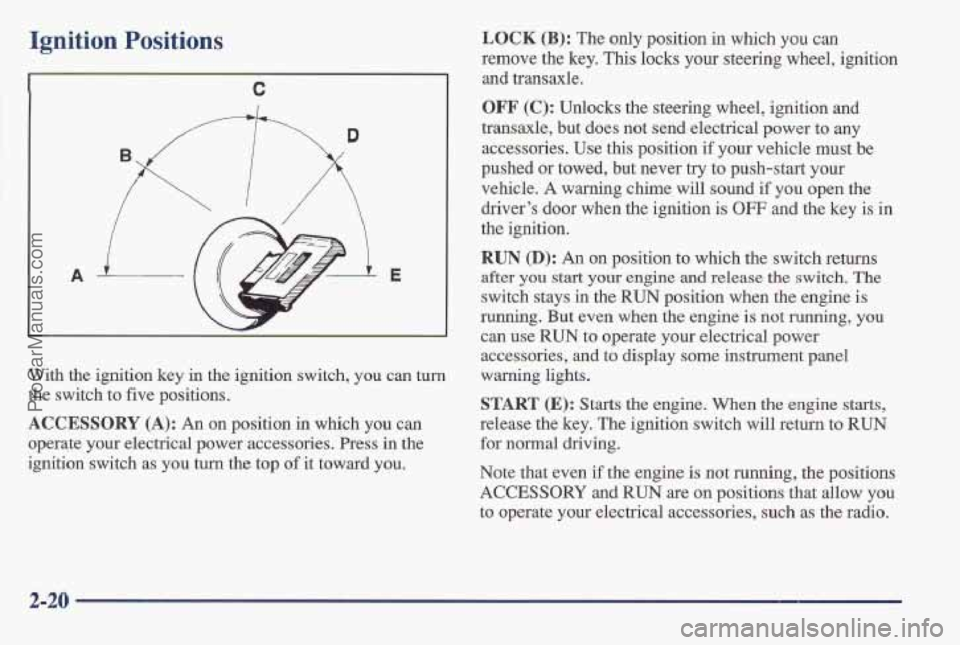
Ignition Positions
C
A E
With the ignition key in the ignition switch, you can turn
the switch to five positions.
ACCESSORY (A): An on position in which you can
operate your electrical power accessories. Press in the
ignition switch as you
turn the top of it toward you.
LOCK (B): The only position in which you can
remove the key. This locks your steering wheel, ignition
and transaxle.
OFF (C): Unlocks the steering wheel, ignition and
transaxle, but does not send electrical power to any
accessories. Use this position if your vehicle must be
pushed
or towed, but never try to push-start your
vehicle.
A warning chime will sound if you open the
driver’s door when the ignition
is OFF and the key is in
the ignition.
RUN (D): An on position to which the switch returns
after you start your engine and release the switch. The
switch stays in the RUN position when the engine is
running. But even when the engine is not running, you
can use RUN
to operate your electrical power
accessories, and
to display some instrument panel
warning lights.
START (E): Starts the engine. When the engine starts,
release the key. The ignition switch will return to RUN
for normal driving.
Note that even
if the engine is not running, the positions
ACCESSORY and RUN are on positions that allow
you
to operate your electrical accessories, such as the radio.
2-20
ProCarManuals.com
Page 99 of 405
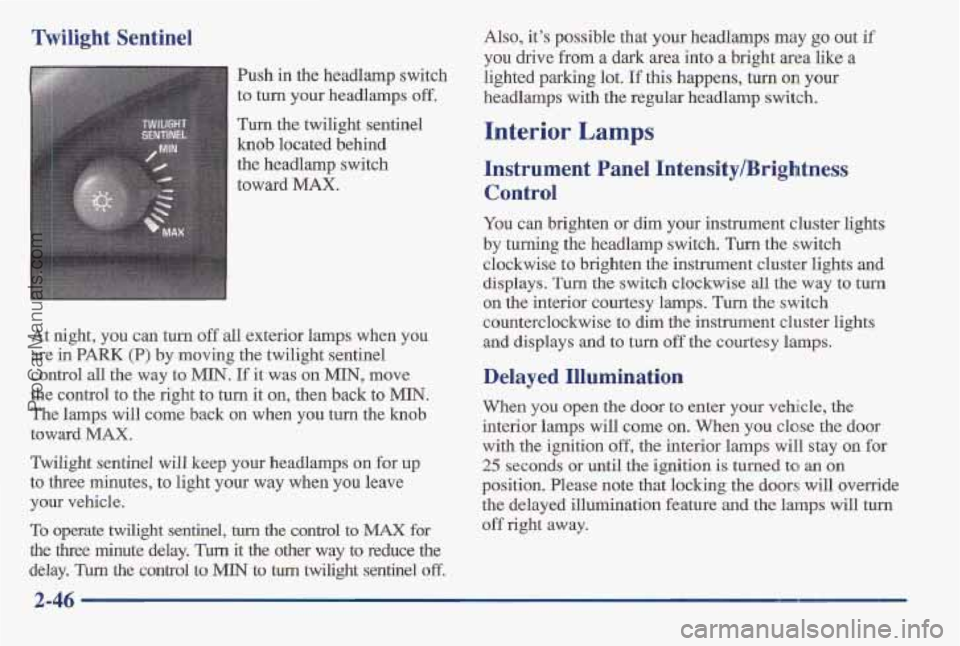
Twilight Sentinel Also, it's possible that your headlamps may go out if
you drive from a dark area into a bright area like a
fish in the headlamp switch
lighted parking lot.
If this happens, turn on your
to turn your headlamps
off. headlamps with the regular headlamp switch,
Turn the twilight sentinel
knob located behind
the headlamp switch
Instrument Panel Intensity/Brightness
toward MAX.
Interior Lamps
Control
You can brighten or dim your instrument cluster lights
by turning the headlamp switch. Turn the switch
clockwise to brighten the instrument cluster lights
and
displays. Turn the switch clockwise all the way to turn
on the interior courtesy lamps. Turn the switch
counterclockwise to dim the instrument cluster lights
and displays and
to turn off the courtesy lamps.
At
night, you can turn off all exterior lamps when you
are in PARK (P) by moving the twilight sentinel
control
all the way to MIN. If it was on MIN, move
the control to the right to turn it on, then back to MIN.
The lamps will come back on when you turn the knob
toward MAX.
Twilight sentinel will keep your headlamps on for up
to three minutes, to light your way when you leave
your vehicle.
To operate twilight sentinel, turn the control to MAX for
the three minute delay. Tm it the other way to reduce the
delay.
Turn the control to MIN to turn twilight sentinel off.
Delayed Illumination
When you open the door to enter your vehicle, the
interior lamps will corne on. When you close the door
with the ignition
off, the interior lamps will stay on for
25 seconds or until the ignition is turned to an on
position. Pleas'e note that locking the doors will override
the delayed illumination feature and
the lamps will turn
off right away.
2-46
ProCarManuals.com
Page 116 of 405
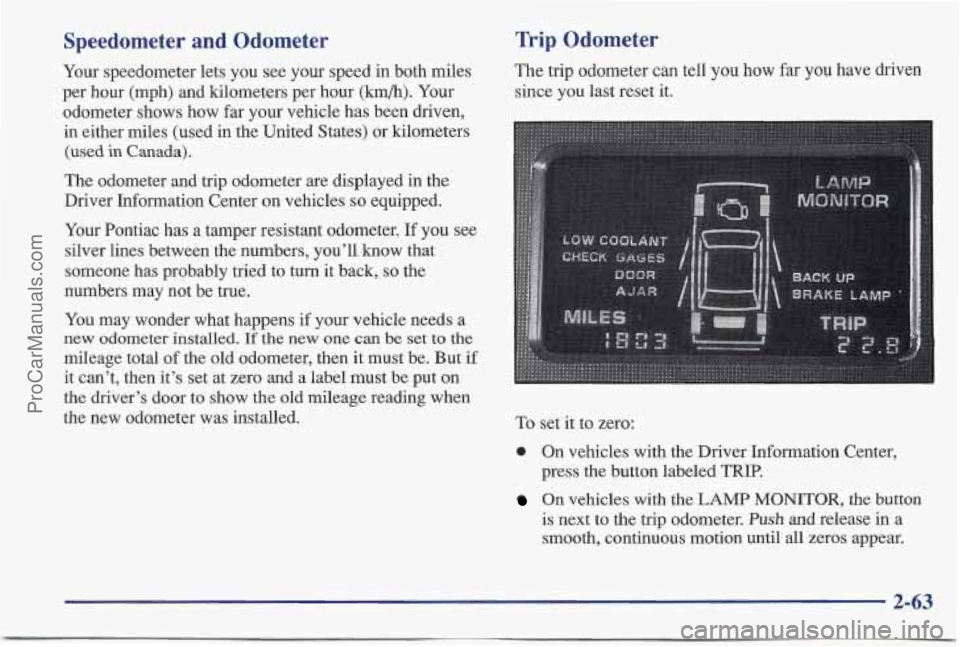
Speedometer and Odometer
Your speedometer lets you see your speed in both miles
per hour (mph) and kilometers per hour
(km/h). Your
odometer shows how far your vehicle has been driven,
in either miles (used in the United States) or kilometers
(used
in Canada).
The odometer and trip Odometer are displayed
in the
Driver Information Center on vehicles
so equipped.
Your Pontiac has a tamper resistant odometer. If you see
silver lines between the numbers, you’ll
know that
someone has probably tried to turn it back,
so the
numbers may not be true.
You may wonder what happens
if your vehicle needs a
new odometer installed.
If the new one can be set to the
mileage total of the old odometer, then it must be. But if
it can’t, then it’s set at zero and
a label must be put on
the driver’s door to show the old mileage reading when
the new odometer was installed.
Trip Odometer
The trip odometer can tell you how far you have driven
since you last reset it.
To set it to zero:
0 On vehicles with the Driver Information Center,
press the button labeled
TRIP.
On vehicles with the LAMP MONITOR, the button
is next to the trip odometer.
Push and release in a
smooth, continuous motion until all zeros appear.
2-63
ProCarManuals.com
Page 129 of 405
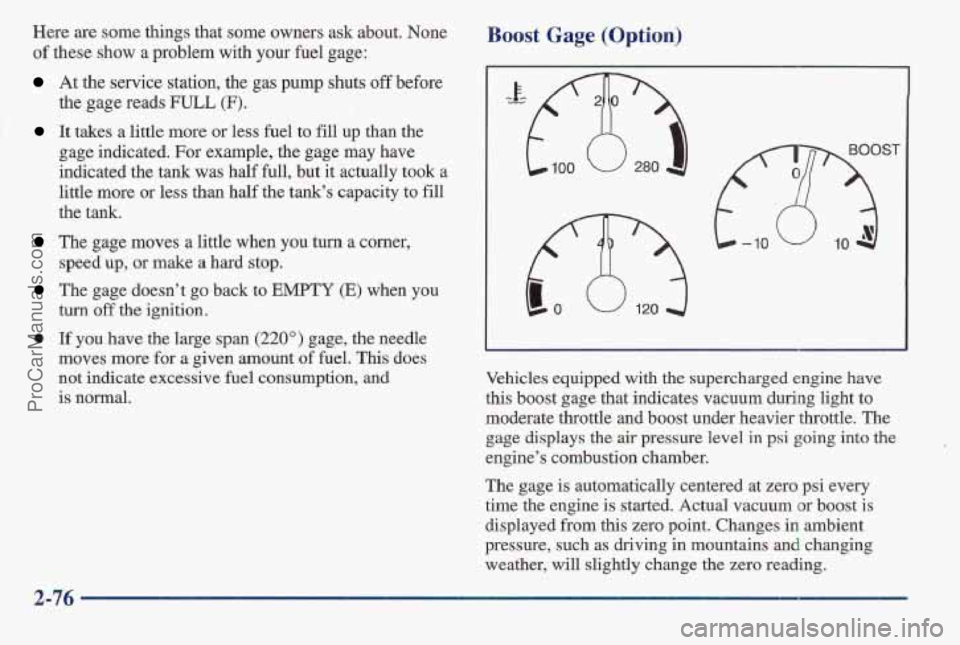
Here are some things that some owners ask about. None
of these show a problem with your fuel gage:
At the service station, the gas pump shuts off before
It takes a little more or less fuel to fill up than the
the
gage reads
FULL (F).
gage indicated. For example, the gage may have
indicated the tank was
half full, but it actually took a
little more or less than half the tank's capacity to fill
the tank.
The gage moves a little when you turn a corner,
The gage doesn't go back to EMPTY (E) when you
0 If you have the large span (220") gage, the needle
moves
more for a given amount of fuel. This does
not indicate excessive fuel consumption, and
is normal.
speed
up, or make
a hard stop.
turn off the ignition.
Boost Gage (Option)
msT -10
Vehicles equipped with the supercharged engine have
this boost gage that indicates vacuum during light to
moderate throttle an'd boost under heavier throttle. The
gage displays
the air pressure level in psi going into the
engine's combustion chamber.
The gage is automatically centered at zero psi every
time the engine is started. Actual vacuum or boost is
displayed from this zero point. Changes in ambient
pressure, such as driving in mountains and changing
weather, will slightly change the zero reading.
2-76
ProCarManuals.com
Page 130 of 405
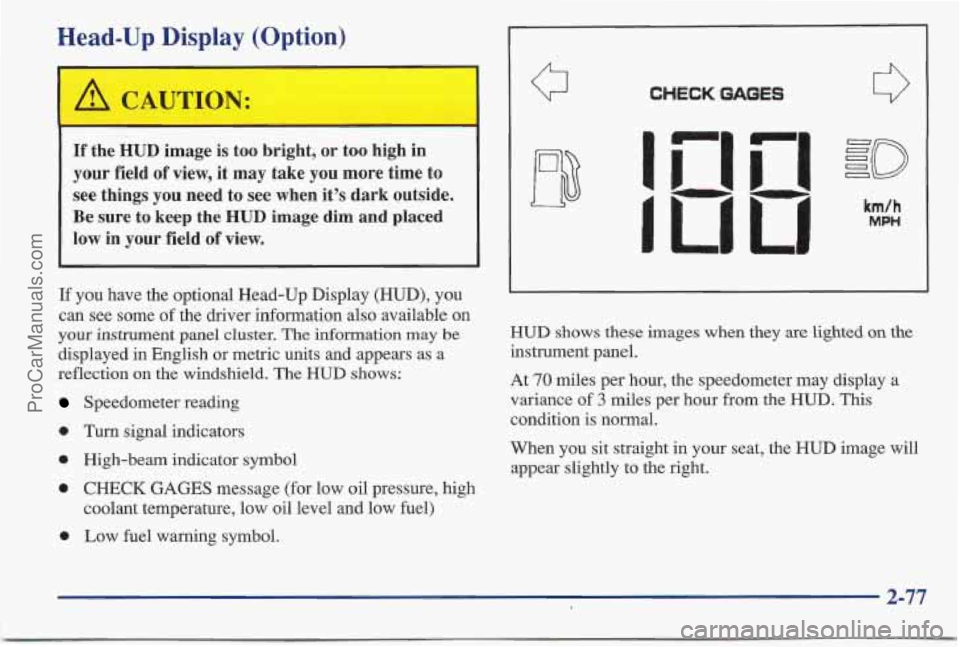
Head-Up Display (Option)
If the HUD image is too bright, or too high in
your field of view, it may take you more time to
see things you need to see when it’s dark outside.
Be sure to keep the HUD image dim and placed
low in
your field of view.
If you have the optional Head-Up Display (HUD), you
can see some of the driver information also available on
your instrument panel cluster. The information may be
displayed in English or metric units and appears as a
reflection on the windshield. The
HUD shows:
Speedometer reading
e Turn signal indicators
0 High-beam indicator symbol
0 CHECK GAGES message (for low oil pressure, high
0 Low fuel warning symbol.
coolant temperature, low oil level and
low fuel)
CHECK GAGES
HUD shows these images when they are lighted on the
instrument panel.
At
70 miles per hour, the speedometer may display a
variance of 3 miles per hour from the HUD. This
condition is normal.
When
you sit straight in your seat, the HUD image will
appear slightly to the right.
2-77
ProCarManuals.com
Page 131 of 405
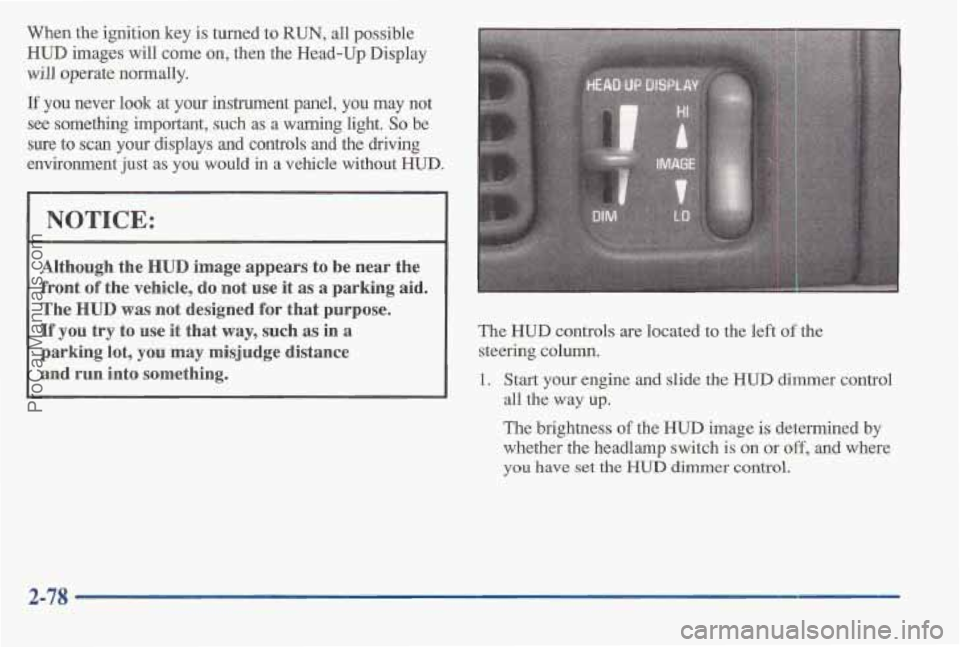
When the ignition key is turned to RUN, all possible
HUD images will come on, then the Head-Up Display
will operate normally.
If you never look at your instrument panel, you may not
see something important, such as a warning light. So be
sure to
scan your displays and controls and the driving
environment just as
you would in a vehicle without HUD.
NOTICE:
Although the HUD image appears to be near the
front
of the vehicle, do not use it as a parking aid.
The
HUD was not designed for that purpose.
If you try to use it that way, such as in a
parking lot,
you may misjudge distance
and run into something.
The HUD controls are located to the left of the
steering
column.
1. Start your engine and slide the HUD dimmer control
all the way up.
The brightness of the HUD image is determined by
whether the headlamp switch
is on or off, and where
you have set the HUD dimmer control.
ProCarManuals.com
Page 137 of 405
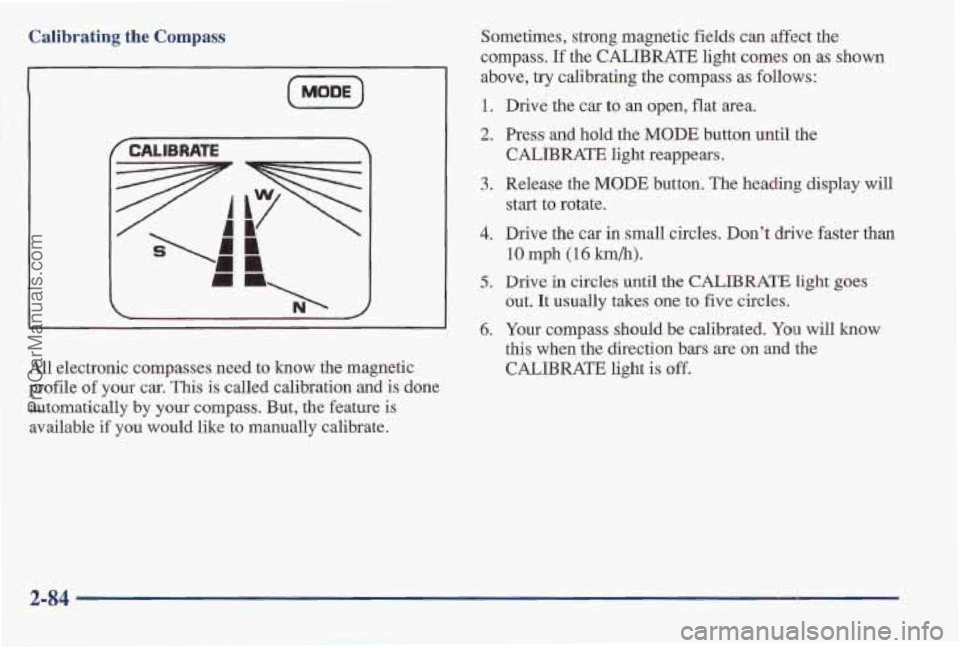
Calibrating the Compass
[MoDE)
CALIBRATE >
All electronic compasses need to kn'ow the magnetic
profile
of your car. This is called calibration and is done
automatically
by your compass. But, the feature is
available
if you would like to manually calibrate. Sometimes,
strong magnetic fields can affect the
compass. If the CALIBRATE light comes
on as shown
above, try calibrating the compass as follows:
1. Drive the car to an open, flat area.
2. Press and hold the MODE button until the
CALIBRATE light reappears,
3. Release the MODE button. The heading display will
4. Drive the car in small circles. Don't drive faster than
start to rotate.
10 mph (16 km/h).
out.
It usually takes one to five circles.
this when the direction bars are on and
the
CALIBRATE light is off.
5. Drive in circles until the CALIBRATE light goes
6. Your compass should be calibrated. You will know
ProCarManuals.com